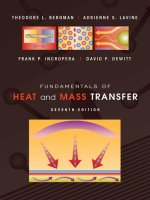Solution manual fundamentals of heat and mass transfer 6th edition ch03
Bạn đang xem bản rút gọn của tài liệu. Xem và tải ngay bản đầy đủ của tài liệu tại đây (28.92 MB, 243 trang )
PROBLEM 3.1
KNOWN: One-dimensional, plane wall separating hot and cold fluids at T∞,1 and T∞ ,2 ,
respectively.
FIND: Temperature distribution, T(x), and heat flux, q ′′x , in terms of T∞ ,1 , T∞ ,2 , h1 , h 2 , k
and L.
SCHEMATIC:
ASSUMPTIONS: (1) One-dimensional conduction, (2) Steady-state conditions, (3) Constant
properties, (4) Negligible radiation, (5) No generation.
ANALYSIS: For the foregoing conditions, the general solution to the heat diffusion equation
is of the form, Equation 3.2,
T ( x ) = C1x + C2 .
(1)
The constants of integration, C1 and C2, are determined by using surface energy balance
conditions at x = 0 and x = L, Equation 2.32, and as illustrated above,
dT ⎤
dT ⎤
−k
= h1 ⎡⎣ T∞,1 − T ( 0 ) ⎤⎦
−k
= h 2 ⎡⎣T ( L ) − T∞,2 ⎤⎦ .
(2,3)
⎥
dt ⎦ x=0
dx ⎦⎥ x=L
For the BC at x = 0, Equation (2), use Equation (1) to find
− k ( C1 + 0 ) = h1 ⎡⎣ T∞,1 − ( C1 ⋅ 0 + C 2 ) ⎤⎦
(4)
and for the BC at x = L to find
− k ( C1 + 0 ) = h 2 ⎡⎣( C1L + C2 ) − T∞,2 ⎤⎦ .
(5)
Multiply Eq. (4) by h2 and Eq. (5) by h1, and add the equations to obtain C1. Then substitute
C1 into Eq. (4) to obtain C2. The results are
T∞,1 − T∞,2
T∞,1 − T∞,2
C1 = −
C2 = −
+ T∞,1
⎡1
⎡1
1 L⎤
1 L⎤
+ ⎥
+ ⎥
k⎢ +
h1 ⎢ +
⎣ h1 h 2 k ⎦
⎣ h1 h 2 k ⎦
T∞,1 − T∞,2 ⎡ x 1 ⎤
<
T (x) = −
⎢ + ⎥ + T∞,1.
⎡1
1 L ⎤ ⎣ k h1 ⎦
⎢h + h + k ⎥
2
⎣ 1
⎦
(
)
(
(
)
)
From Fourier’s law, the heat flux is a constant and of the form
T∞,1 − T∞,2
dT
= − k C1 = +
q′′x = − k
.
dx
⎡1
1 L⎤
⎢h + h + k ⎥
2
⎣ 1
⎦
(
)
<
Excerpts from this work may be reproduced by instructors for distribution on a not-for-profit basis for testing or instructional purposes only to students enrolled in
courses for which the textbook has been adopted. Any other reproduction or translation of this work beyond that permitted by Sections 107 or 108 of the 1976
United States Copyright Act without the permission of the copyright owner is unlawful.
PROBLEM 3.2
KNOWN: Temperatures and convection coefficients associated with air at the inner and outer surfaces
of a rear window.
FIND: (a) Inner and outer window surface temperatures, Ts,i and Ts,o, and (b) Ts,i and Ts,o as a function of
the outside air temperature T∞,o and for selected values of outer convection coefficient, ho.
SCHEMATIC:
ASSUMPTIONS: (1) Steady-state conditions, (2) One-dimensional conduction, (3) Negligible radiation
effects, (4) Constant properties.
PROPERTIES: Table A-3, Glass (300 K): k = 1.4 W/m⋅K.
ANALYSIS: (a) The heat flux may be obtained from Eqs. 3.11 and 3.12,
)
(
40o C − −10o C
T∞,i − T∞,o
=
q′′ =
1 L 1
1
0.004 m
1
+ +
+
+
ho k hi
65 W m 2 ⋅ K 1.4 W m ⋅ K 30 W m 2 ⋅ K
q′′ =
50o C
( 0.0154 + 0.0029 + 0.0333) m
(
2
⋅K W
= 969 W m 2 .
)
Hence, with q′′ = h i T∞,i − T∞,o , the inner surface temperature is
Ts,i = T∞,i −
q′′
hi
= 40o C −
969 W m 2
30 W m 2 ⋅ K
(
Similarly for the outer surface temperature with q′′ = h o Ts,o − T∞ ,o
Ts,o = T∞,o +
q′′
= −10o C +
969 W m 2
2
<
= 7.7o C
= 4.9o C
) find
<
65 W m ⋅ K
(b) Using the same analysis, Ts,i and Ts,o have been computed and plotted as a function of the outside air
temperature, T∞,o, for outer convection coefficients of ho = 2, 65, and 100 W/m2⋅K. As expected, Ts,i and
Ts,o are linear with changes in the outside air temperature. The difference between Ts,i and Ts,o increases
with increasing convection coefficient, since the heat flux through the window likewise increases. This
difference is larger at lower outside air temperatures for the same reason. Note that with ho = 2 W/m2⋅K,
Ts,i - Ts,o, is too small to show on the plot.
ho
Continued …..
Excerpts from this work may be reproduced by instructors for distribution on a not-for-profit basis for testing or instructional purposes only to students enrolled in
courses for which the textbook has been adopted. Any other reproduction or translation of this work beyond that permitted by Sections 107 or 108 of the 1976
United States Copyright Act without the permission of the copyright owner is unlawful.
Surface temperatures, Tsi or Tso (C)
PROBLEM 3.2 (Cont.)
40
30
20
10
0
-10
-20
-30
-30
-25
-20
-15
-10
-5
0
Outside air temperature, Tinfo (C)
Tsi; ho = 100 W/m^2.K
Tso; ho = 100 W/m^2.K
Tsi; ho = 65 W/m^2.K
Tso; ho = 65 W/m^2.K
Tsi or Tso; ho = 2 W/m^.K
COMMENTS: (1) The largest resistance is that associated with convection at the inner surface. The
values of Ts,i and Ts,o could be increased by increasing the value of hi.
(2) The IHT Thermal Resistance Network Model was used to create a model of the window and generate
the above plot. The Workspace is shown below.
// Thermal Resistance Network Model:
// The Network:
// Heat rates into node j,qij, through thermal resistance Rij
q21 = (T2 - T1) / R21
q32 = (T3 - T2) / R32
q43 = (T4 - T3) / R43
// Nodal energy balances
q1 + q21 = 0
q2 - q21 + q32 = 0
q3 - q32 + q43 = 0
q4 - q43 = 0
/* Assigned variables list: deselect the qi, Rij and Ti which are unknowns; set qi = 0 for embedded nodal points
at which there is no external source of heat. */
T1 = Tinfo
// Outside air temperature, C
//q1 =
// Heat rate, W
T2 = Tso
// Outer surface temperature, C
q2 = 0
// Heat rate, W; node 2, no external heat source
T3 = Tsi
// Inner surface temperature, C
q3 = 0
// Heat rate, W; node 2, no external heat source
T4 = Tinfi
// Inside air temperature, C
//q4 =
// Heat rate, W
// Thermal Resistances:
R21 = 1 / ( ho * As )
R32 = L / ( k * As )
R43 = 1 / ( hi * As )
// Convection thermal resistance, K/W; outer surface
// Conduction thermal resistance, K/W; glass
// Convection thermal resistance, K/W; inner surface
// Other Assigned Variables:
Tinfo = -10
// Outside air temperature, C
ho = 65
// Convection coefficient, W/m^2.K; outer surface
L = 0.004
// Thickness, m; glass
k = 1.4
// Thermal conductivity, W/m.K; glass
Tinfi = 40
// Inside air temperature, C
hi = 30
// Convection coefficient, W/m^2.K; inner surface
As = 1
// Cross-sectional area, m^2; unit area
Excerpts from this work may be reproduced by instructors for distribution on a not-for-profit basis for testing or instructional purposes only to students enrolled in
courses for which the textbook has been adopted. Any other reproduction or translation of this work beyond that permitted by Sections 107 or 108 of the 1976
United States Copyright Act without the permission of the copyright owner is unlawful.
PROBLEM 3.3
KNOWN: Desired inner surface temperature of rear window with prescribed inside and outside air
conditions.
FIND: (a) Heater power per unit area required to maintain the desired temperature, and (b) Compute and
plot the electrical power requirement as a function of T∞,o for the range -30 ≤ T∞,o ≤ 0°C with ho of 2,
20, 65 and 100 W/m2⋅K. Comment on heater operation needs for low ho. If h ~ Vn, where V is the
vehicle speed and n is a positive exponent, how does the vehicle speed affect the need for heater
operation?
SCHEMATIC:
ASSUMPTIONS: (1) Steady-state conditions, (2) One-dimensional heat transfer, (3) Uniform heater
flux, q′′h , (4) Constant properties, (5) Negligible radiation effects, (6) Negligible film resistance.
PROPERTIES: Table A-3, Glass (300 K): k = 1.4 W/m⋅K.
ANALYSIS: (a) From an energy balance at the inner surface and the thermal circuit, it follows that for a
unit surface area,
T∞ ,i − Ts,i
1 hi
q ′′h =
Ts,i − T∞ ,o
+ q ′′h =
L k + 1 ho
Ts,i − T∞ ,o
L k + 1 ho
−
T∞,i − Ts,i
(
o
o
15 C − −10 C
=
1 hi
0.004 m
1.4 W m ⋅ K
q ′′h = (1370 − 100 ) W m = 1270 W m
2
+
)
−
1
2
65 W m ⋅ K
o
o
25 C − 15 C
1
2
10 W m ⋅ K
<
2
(b) The heater electrical power requirement as a function of the exterior air temperature for different
exterior convection coefficients is shown in the plot. When ho = 2 W/m2⋅K, the heater is unecessary,
since the glass is maintained at 15°C by the interior air. If h ~ Vn, we conclude that, with higher vehicle
speeds, the exterior convection will increase, requiring increased heat power to maintain the 15°C
condition.
3500
Heater power (W/m^2)
3000
2500
2000
1500
1000
500
0
-30
-20
-10
0
Exterior air temperature, Tinfo (C)
h = 20 W/m^2.K
h = 65 W/m^2.K
h = 100 W/m^2.K
COMMENTS: With q ′′h = 0, the inner surface temperature with T∞,o = -10°C would be given by
T∞,i − Ts,i
T∞,i − T∞ ,o
=
1 hi
0.10
=
= 0.846,
1 h i + L k + 1 h o 0.118
or
o
( )
o
o
Ts,i = 25 C − 0.846 35 C = − 4.6 C .
Excerpts from this work may be reproduced by instructors for distribution on a not-for-profit basis for testing or instructional purposes only to students enrolled in
courses for which the textbook has been adopted. Any other reproduction or translation of this work beyond that permitted by Sections 107 or 108 of the 1976
United States Copyright Act without the permission of the copyright owner is unlawful.
PROBLEM 3.4
KNOWN: Curing of a transparent film by radiant heating with substrate and film surface subjected to
known thermal conditions.
FIND: (a) Thermal circuit for this situation, (b) Radiant heat flux, q′′o (W/m2), to maintain bond at
curing temperature, To, (c) Compute and plot q′′o as a function of the film thickness for 0 ≤ Lf ≤ 1 mm,
and (d) If the film is not transparent, determine q′′o required to achieve bonding; plot results as a function
of Lf.
SCHEMATIC:
ASSUMPTIONS: (1) Steady-state conditions, (2) One-dimensional heat flow, (3) All the radiant heat
flux q′′o is absorbed at the bond, (4) Negligible contact resistance.
ANALYSIS: (a) The thermal circuit for
this situation is shown at the right. Note
that terms are written on a per unit area
basis.
(b) Using this circuit and performing an energy balance on the film-substrate interface,
q′′o = q1′′ + q′′2
q′′o =
To − T∞
T −T
+ o 1
R ′′cv + R ′′f
R ′′s
where the thermal resistances are
R ′′cv = 1 h = 1 50 W m 2 ⋅ K = 0.020 m 2 ⋅ K W
R ′′f = Lf k f = 0.00025 m 0.025 W m ⋅ K = 0.010 m 2 ⋅ K W
R s′′ = Ls k s = 0.001m 0.05 W m ⋅ K = 0.020 m 2 ⋅ K W
q′′o =
( 60 − 20 )o C
[0.020 + 0.010] m2 ⋅ K
+
W
( 60 − 30 )o C
2
0.020 m ⋅ K W
= (1333 + 1500 ) W m 2 = 2833 W m 2
<
(c) For the transparent film, the radiant flux required to achieve bonding as a function of film thickness Lf
is shown in the plot below.
(d) If the film is opaque (not transparent), the thermal circuit is shown below. In order to find q′′o , it is
necessary to write two energy balances, one around the Ts node and the second about the To node.
.
The results of the analysis are plotted below.
Continued...
Excerpts from this work may be reproduced by instructors for distribution on a not-for-profit basis for testing or instructional purposes only to students enrolled in
courses for which the textbook has been adopted. Any other reproduction or translation of this work beyond that permitted by Sections 107 or 108 of the 1976
United States Copyright Act without the permission of the copyright owner is unlawful.
PROBLEM 3.4 (Cont.)
Radiant heat flux, q''o (W/m^2)
7000
6000
5000
4000
3000
2000
0
0.2
0.4
0.6
0.8
1
Film thickness, Lf (mm)
Opaque film
Transparent film
COMMENTS: (1) When the film is transparent, the radiant flux is absorbed on the bond. The flux
required decreases with increasing film thickness. Physically, how do you explain this? Why is the
relationship not linear?
(2) When the film is opaque, the radiant flux is absorbed on the surface, and the flux required increases
with increasing thickness of the film. Physically, how do you explain this? Why is the relationship
linear?
(3) The IHT Thermal Resistance Network Model was used to create a model of the film-substrate system
and generate the above plot. The Workspace is shown below.
// Thermal Resistance Network
Model:
// The Network:
// Heat rates into node j,qij, through thermal resistance Rij
q21 = (T2 - T1) / R21
q32 = (T3 - T2) / R32
q43 = (T4 - T3) / R43
// Nodal energy balances
q1 + q21 = 0
q2 - q21 + q32 = 0
q3 - q32 + q43 = 0
q4 - q43 = 0
/* Assigned variables list: deselect the qi, Rij and Ti which are unknowns; set qi = 0 for embedded nodal points
at which there is no external source of heat. */
T1 = Tinf
// Ambient air temperature, C
//q1 =
// Heat rate, W; film side
T2 = Ts
// Film surface temperature, C
q2 = 0
// Radiant flux, W/m^2; zero for part (a)
T3 = To
// Bond temperature, C
q3 = qo
// Radiant flux, W/m^2; part (a)
T4 = Tsub
// Substrate temperature, C
//q4 =
// Heat rate, W; substrate side
// Thermal Resistances:
R21 = 1 / ( h * As )
// Convection resistance, K/W
R32 = Lf / (kf * As)
// Conduction resistance, K/W; film
R43 = Ls / (ks * As) // Conduction resistance, K/W; substrate
// Other Assigned Variables:
Tinf = 20
// Ambient air temperature, C
h = 50
// Convection coefficient, W/m^2.K
Lf = 0.00025
// Thickness, m; film
kf = 0.025
// Thermal conductivity, W/m.K; film
To = 60
// Cure temperature, C
Ls = 0.001
// Thickness, m; substrate
ks = 0.05
// Thermal conductivity, W/m.K; substrate
Tsub = 30 // Substrate temperature, C
As = 1
// Cross-sectional area, m^2; unit area
Excerpts from this work may be reproduced by instructors for distribution on a not-for-profit basis for testing or instructional purposes only to students enrolled in
courses for which the textbook has been adopted. Any other reproduction or translation of this work beyond that permitted by Sections 107 or 108 of the 1976
United States Copyright Act without the permission of the copyright owner is unlawful.
PROBLEM 3.5
KNOWN: Thicknesses and thermal conductivities of refrigerator wall materials. Inner and outer air
temperatures and convection coefficients.
FIND: Heat gain per surface area.
SCHEMATIC:
ASSUMPTIONS: (1) One-dimensional heat transfer, (2) Steady-state conditions, (3) Negligible
contact resistance, (4) Negligible radiation, (5) Constant properties.
ANALYSIS: From the thermal circuit, the heat gain per unit surface area is
q′′ =
q′′ =
q′′ =
T∞,o − T∞,i
(1/ hi ) + ( Lp / k p ) + ( Li / ki ) + ( Lp / k p ) + (1/ h o )
(
)
( 25 − 4 ) °C
2 1/ 5 W / m 2 ⋅ K + 2 ( 0.003m / 60 W / m ⋅ K ) + ( 0.050m / 0.046 W / m ⋅ K )
21°C
( 0.4 + 0.0001 + 1.087 ) m2 ⋅ K / W
= 14.1 W / m 2
<
COMMENTS: Although the contribution of the panels to the total thermal resistance is negligible,
that due to convection is not inconsequential and is comparable to the thermal resistance of the
insulation.
Excerpts from this work may be reproduced by instructors for distribution on a not-for-profit basis for testing or instructional purposes only to students enrolled in
courses for which the textbook has been adopted. Any other reproduction or translation of this work beyond that permitted by Sections 107 or 108 of the 1976
United States Copyright Act without the permission of the copyright owner is unlawful.
PROBLEM 3.6
KNOWN: Design and operating conditions of a heat flux gage.
FIND: (a) Convection coefficient for water flow (Ts = 27°C) and error associated with neglecting
conduction in the insulation, (b) Convection coefficient for air flow (Ts = 125°C) and error associated
with neglecting conduction and radiation, (c) Effect of convection coefficient on error associated with
neglecting conduction for Ts = 27°C.
SCHEMATIC:
ε ε= =0.15
0.15
ASSUMPTIONS: (1) Steady-state, (2) One-dimensional conduction, (3) Constant k.
ANALYSIS: (a) The electric power dissipation is balanced by convection to the water and conduction
through the insulation. An energy balance applied to a control surface about the foil therefore yields
′′ = q′′conv + q′′cond = h ( Ts − T∞ ) + k ( Ts − Tb ) L
Pelec
Hence,
P′′ − k ( Ts − Tb ) L 2000 W m 2 − 0.04 W m ⋅ K ( 2 K ) 0.01m
=
h = elec
Ts − T∞
2K
h=
( 2000 − 8 ) W
2K
m2
<
= 996 W m 2 ⋅ K
If conduction is neglected, a value of h = 1000 W/m2⋅K is obtained, with an attendant error of (1000 996)/996 = 0.40%
(b) In air, energy may also be transferred from the foil surface by radiation, and the energy balance yields
)
(
4
′′ = q′′conv + q′′rad + q′′cond = h ( Ts − T∞ ) + εσ Ts4 − Tsur
Pelec
+ k ( Ts − Tb ) L
Hence,
h=
)
(
4
′′ − εσ Ts4 − Tsur
Pelec
− k ( Ts − T∞ ) L
Ts − T∞
2
2000 W m − 0.15 × 5.67 × 10
=
−8
2
W m ⋅K
4
(398
4
− 298
4
)K
4
− 0.04 W m ⋅ K (100 K) / 0.01m
100 K
=
( 2000 − 146 − 400 ) W
100 K
m2
= 14.5 W m 2 ⋅ K
<
Continued...
Excerpts from this work may be reproduced by instructors for distribution on a not-for-profit basis for testing or instructional purposes only to students enrolled in
courses for which the textbook has been adopted. Any other reproduction or translation of this work beyond that permitted by Sections 107 or 108 of the 1976
United States Copyright Act without the permission of the copyright owner is unlawful.
PROBLEM 3.6 (Cont.)
If conduction, radiation, or conduction and radiation are neglected, the corresponding values of h and the
percentage errors are 18.5 W/m2⋅K (27.6%), 16 W/m2⋅K (10.3%), and 20 W/m2⋅K (37.9%).
(c) For a fixed value of Ts = 27°C, the conduction loss remains at q′′cond = 8 W/m2, which is also the
′′ and q′′conv . Although this difference is not clearly shown in the plot for
fixed difference between Pelec
10 ≤ h ≤ 1000 W/m2⋅K, it is revealed in the subplot for 10 ≤ 100 W/m2⋅K.
200
Power dissipation, P''elec(W/m^2)
Power dissipation, P''elec(W/m^2)
2000
1600
1200
800
400
0
160
120
80
40
0
0
200
400
600
800
Convection coefficient, h(W/m^2.K)
No conduction
With conduction
1000
0
20
40
60
80
100
Convection coefficient, h(W/m^2.K)
No conduction
With conduction
Errors associated with neglecting conduction decrease with increasing h from values which are significant
for small h (h < 100 W/m2⋅K) to values which are negligible for large h.
COMMENTS: In liquids (large h), it is an excellent approximation to neglect conduction and assume
that all of the dissipated power is transferred to the fluid.
Excerpts from this work may be reproduced by instructors for distribution on a not-for-profit basis for testing or instructional purposes only to students enrolled in
courses for which the textbook has been adopted. Any other reproduction or translation of this work beyond that permitted by Sections 107 or 108 of the 1976
United States Copyright Act without the permission of the copyright owner is unlawful.
PROBLEM 3.7
KNOWN: A layer of fatty tissue with fixed inside temperature can experience different
outside convection conditions.
FIND: (a) Ratio of heat loss for different convection conditions, (b) Outer surface
temperature for different convection conditions, and (c) Temperature of still air which
achieves same cooling as moving air (wind chill effect).
SCHEMATIC:
ASSUMPTIONS: (1) One-dimensional conduction through a plane wall, (2) Steady-state
conditions, (3) Homogeneous medium with constant properties, (4) No internal heat
generation (metabolic effects are negligible), (5) Negligible radiation effects.
PROPERTIES: Table A-3, Tissue, fat layer: k = 0.2 W/m⋅K.
ANALYSIS: The thermal circuit for this situation is
Hence, the heat rate is
q=
Ts,1 − T∞
R tot
=
Ts,1 − T∞
L/kA + 1/ hA
.
Therefore,
⎡L 1⎤
⎢⎣ k + h ⎥⎦
windy
q′′calm
=
.
q′′windy
⎡L 1⎤
⎢⎣ k + h ⎥⎦
calm
Applying a surface energy balance to the outer surface, it also follows that
q′′cond = q′′conv .
Continued …..
Excerpts from this work may be reproduced by instructors for distribution on a not-for-profit basis for testing or instructional purposes only to students enrolled in
courses for which the textbook has been adopted. Any other reproduction or translation of this work beyond that permitted by Sections 107 or 108 of the 1976
United States Copyright Act without the permission of the copyright owner is unlawful.
PROBLEM 3.7 (Cont.)
Hence,
(
)
(
k
Ts,1 − Ts,2 = h Ts,2 − T∞
L
k
T∞ +
Ts,1
hL
Ts,2 =
.
k
1+
hL
)
To determine the wind chill effect, we must determine the heat loss for the windy day and use
it to evaluate the hypothetical ambient air temperature, T∞′ , which would provide the same
heat loss on a calm day, Hence,
q′′ =
Ts,1 − T∞
⎡L 1⎤
⎢⎣ k + h ⎥⎦
windy
=
′
Ts,1 − T∞
⎡L 1⎤
⎢⎣ k + h ⎥⎦
calm
From these relations, we can now find the results sought:
(a)
0.003 m
1
+
q′′calm
0.2 W/m ⋅ K 65 W/m 2 ⋅ K 0.015 + 0.0154
=
=
0.003 m
1
q′′windy
0.015 + 0.04
+
2
0.2 W/m ⋅ K 25 W/m ⋅ K
q′′calm
= 0.553
q′′windy
<
−15o C +
(b)
Ts,2 ⎤⎦
calm
=
1+
(
0.2 W/m ⋅ K
(c)
windy
36o C
0.2 W/m ⋅ K
= 22.1o C
<
= 10.8o C
<
( 25 W/m2 ⋅ K ) (0.003 m )
−15o C +
Ts,2 ⎤⎦
)
25 W/m 2 ⋅ K ( 0.003 m )
=
1+
o
0.2 W/m ⋅ K
( 65 W/m2 ⋅ K ) ( 0.003m )
0.2 W/m ⋅ K
36o C
( 65 W/m2 ⋅ K ) ( 0.003m )
′ = 36o C − ( 36 + 15 ) C
T∞
( 0.003/0.2 + 1/ 25) = −56.3o C
( 0.003 / 0.2 + 1/ 65)
<
COMMENTS: The wind chill effect is equivalent to a decrease of Ts,2 by 11.3°C and
-1
increase in the heat loss by a factor of (0.553) = 1.81.
Excerpts from this work may be reproduced by instructors for distribution on a not-for-profit basis for testing or instructional purposes only to students enrolled in
courses for which the textbook has been adopted. Any other reproduction or translation of this work beyond that permitted by Sections 107 or 108 of the 1976
United States Copyright Act without the permission of the copyright owner is unlawful.
Excerpts from this work may be reproduced by instructors for distribution on a not-for-profit basis for testing or instructional purposes only to students enrolled in
courses for which the textbook has been adopted. Any other reproduction or translation of this work beyond that permitted by Sections 107 or 108 of the 1976
United States Copyright Act without the permission of the copyright owner is unlawful.
Excerpts from this work may be reproduced by instructors for distribution on a not-for-profit basis for testing or instructional purposes only to students enrolled in
courses for which the textbook has been adopted. Any other reproduction or translation of this work beyond that permitted by Sections 107 or 108 of the 1976
United States Copyright Act without the permission of the copyright owner is unlawful.
Excerpts from this work may be reproduced by instructors for distribution on a not-for-profit basis for testing or instructional purposes only to students enrolled in
courses for which the textbook has been adopted. Any other reproduction or translation of this work beyond that permitted by Sections 107 or 108 of the 1976
United States Copyright Act without the permission of the copyright owner is unlawful.
PROBLEM 3.10
KNOWN: Construction and dimensions of a device to measure the temperature dependence of a
liquid’s thermal conductivity.
FIND: (a) Overall height of the apparatus using bakelite, (b) Overall height of the apparatus
using aerogel, (c) Required heater area and electrical power to minimize heat losses for bakelite
and aerogel.
SCHEMATIC:
Stainless Steel
Liquid layer 1
Sandwich
tl = 2 mm
kss = 15 W/m·K
kl = 0.8 W/m·K
∆Tl = 2°C
Liquid layer 2
Sandwich
H
Liquid layer 3
Sandwich
tss = 1 mm
Liquid layer 4
Sandwich
Stainless Steel
Low Thermal Conductivity
Stainless Steel
Liquid layer 5
Stainless Steel
tlcm
Sandwich structure
ASSUMPTIONS: (1) Steady-state conditions, (2) One-dimensional heat transfer.
PROPERTIES: Table A.3, bakelite (300 K): k = 1.4 W/m⋅K.
ANALYSIS: The heat flux through the device is constant and is evaluated using Eq. 3.5
∆Tl
0.8 W/m ⋅ K × 2°C
=
= 800 W/m 2
tl
2 × 10-3 m
For each stainless steel sheet,
∆T
q′′t ss
800 W/m 2 × 1 × 10-3 m
q′′ = k ss ss or ∆Tss =
=
= 0.053°C
t ss
k ss
15 W/m ⋅ K
The temperature difference from top to bottom is
q′′ = k l
∆Ttot = ∆Tss × N × 2 + ∆Tl × N + ∆Tlcm × (N - 1)
or
∆Tlcm =
1
1
∆Ttot - ∆Tss × N × 2 - ∆Tl × N ] = [100°C - 0.053°C × 10 - 2°C × 5] = 22.4°C
[
(N - 1)
4
For the low thermal conductivity material, q′′ = k lcm
∆Tlcm
t lcm
or t lcm =
k lcm ∆Tlcm
.
q′′
(a) For bakelite,
1.4 W/m ⋅ K × 22.4°C
t lcm =
= 39.2 × 10-3 m
2
800 W/m
Continued…
Excerpts from this work may be reproduced by instructors for distribution on a not-for-profit basis for testing or instructional purposes only to students enrolled in
courses for which the textbook has been adopted. Any other reproduction or translation of this work beyond that permitted by Sections 107 or 108 of the 1976
United States Copyright Act without the permission of the copyright owner is unlawful.
PROBLEM 3.10 (Cont.)
The total height is
H = 2Nt ss + Nt l + (N - 1)t lcm
= 2 × 5 × 1 × 10-3 m + 5 × 2 × 10-3 m + (5 - 1) × 39.2 × 10-3 m
<
= 177 × 10-3 m = 177 mm
(b) For aerogel,
t lcm =
0.0065 W/m ⋅ K × 22.4°C
800 W/m
2
= 182 × 10-6 m = 182 µm
The total height is
H = 2N × t ss + Nt l + (N - 1)t lcm
= 2 × 5 × 1 × 10-3 m + 5 × 2 × 10-3 m + (5 - 1) × 182 × 10-6 m
= 20.7 × 10-3 m = 20.7 mm
<
(c) For side area, As = 4HL and heater area, Ah = L2. The heater-to-side area ratio is
L2
L
10 =
=
or L = 40 H
4HL
4H
For bakelite, L = 40 × 177 mm = 7.1 m and
q = q′′A h = 800 W/m 2 × (7.1m)2 = 40.3 × 103 W = 40.3 kW
<
For aerogel, L = 40 × 20.7 mm = 830 mm = 0.83 m and
q = q′′A h = 800 W/m 2 × (0.83 m) 2 = 550 W
<
COMMENTS: (1) It may be expected that the small device utilizing the aerogel low thermal
conductivity material will reach steady-state faster than the large device using the bakelite plates.
(2) The stainless steel sheets are isothermal to within 0.053 degrees Celsius. Precise placement of
the thermocouple beads on the stainless steel sheets is not required. (3) The device constructed of
bakelite is large. The device constructed of the nanostructured aerogel material reasonably sized.
Excerpts from this work may be reproduced by instructors for distribution on a not-for-profit basis for testing or instructional purposes only to students enrolled in
courses for which the textbook has been adopted. Any other reproduction or translation of this work beyond that permitted by Sections 107 or 108 of the 1976
United States Copyright Act without the permission of the copyright owner is unlawful.









